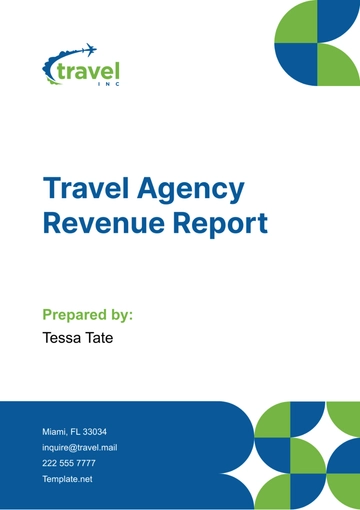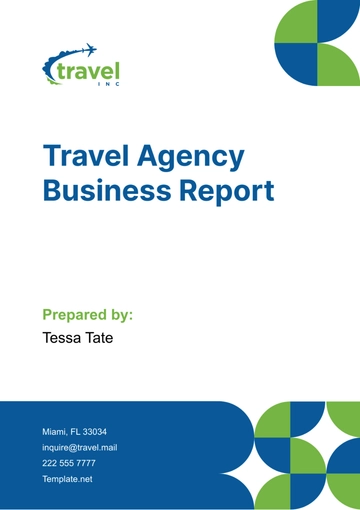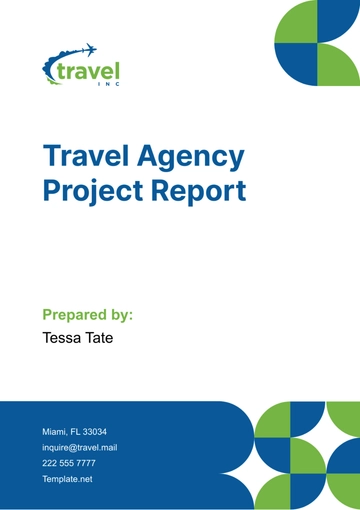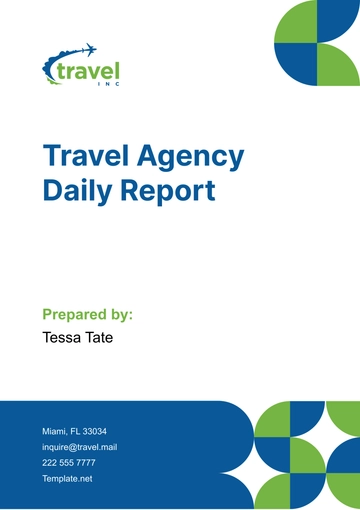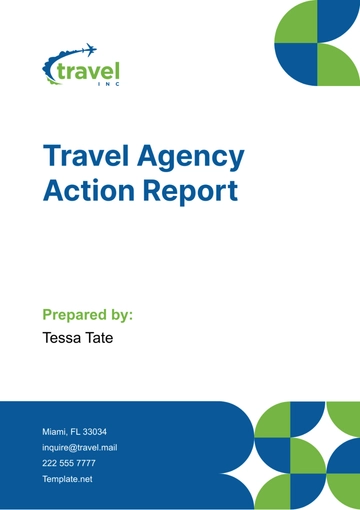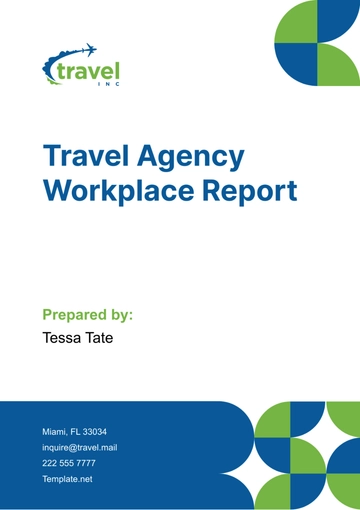Free Travel Agency Revenue Report
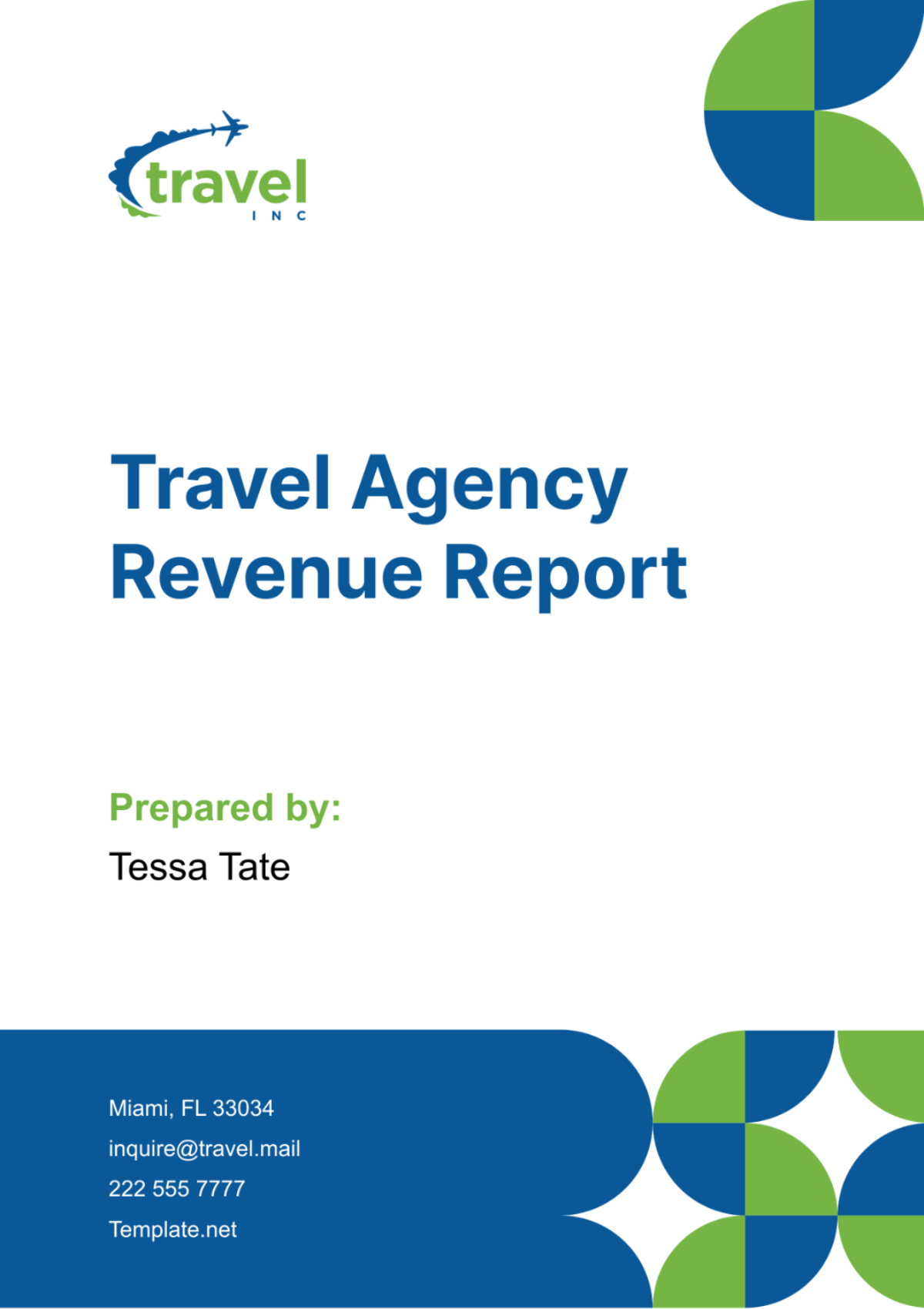
I. Executive Summary
A. Overview
This report presents an in-depth analysis of the revenue performance of [Your Company Name]'s travel agency division during the first quarter of 2050. As the global travel industry continues to recover from the impact of the COVID-19 pandemic, understanding revenue trends and identifying key drivers of growth are essential for strategic decision-making.
Despite ongoing challenges, such as fluctuating travel restrictions and economic uncertainty, [Your Company Name] has demonstrated resilience and agility in adapting to market dynamics. This report aims to provide insights into revenue trends, performance against targets, and factors influencing revenue generation, thus facilitating informed decision-making and strategy formulation.
II. Revenue Performance Analysis
A. Quarterly Revenue Overview
Total Revenue: [$2,500,000]
The total revenue generated by [Your Company Name]'s travel agency division in the first quarter of 2050 amounted to [$2,500,000], reflecting a [15%] growth compared to the same period last year.
This growth trajectory underscores the effectiveness of strategic initiatives implemented to stimulate demand and capitalize on emerging opportunities in the travel market.
Revenue Growth Rate: [15%]
The [15%] year-over-year revenue growth rate indicates a positive momentum in revenue generation, signaling recovery from the adverse effects of the pandemic and a return to pre-pandemic levels of activity.
Comparison with Previous Quarter: [10% increase]
Compared to the previous quarter, [Your Company Name] witnessed a [10%] increase in revenue, highlighting sustained growth momentum and the successful execution of revenue-generating strategies.
B. Revenue Breakdown by Service
Analyzing revenue distribution by service provides valuable insights into the performance of key revenue streams within [Your Company Name]'s travel agency division. The breakdown is as follows:
Airline Ticket Sales: [$1,200,000]
Airline ticket sales accounted for [$1,200,000] in revenue during the first quarter, representing [48%] of total revenue. The breakdown by destination reveals a robust performance in both domestic and international markets, with domestic ticket sales contributing [$800,000] and international ticket sales contributing [$400,000] to overall revenue.
The growth in airline ticket sales can be attributed to increased travel demand as vaccination efforts progress, easing travel restrictions, and enhanced marketing efforts to promote travel packages and discounted fares.
Hotel Bookings: [$800,000]
Hotel bookings generated [$800,000] in revenue, comprising [32%] of total revenue. Revenue distribution by location indicates a preference for urban destinations, which accounted for [$600,000] in revenue, while resort bookings contributed [$200,000].
The surge in urban hotel bookings reflects a growing preference for city getaways and business travel, driven by pent-up demand and easing travel restrictions in key urban centers.
Tour Packages: [$500,000]
Tour packages generated [$500,000] in revenue, accounting for [20%] of total revenue. Revenue distribution by type highlights the popularity of adventure and cultural tours, which contributed [$300,000] and [$200,000], respectively.
The strong performance of tour packages underscores the appeal of experiential travel and curated experiences, as travelers seek immersive and authentic experiences post-pandemic.
C. Revenue Trends and Insights
Analyzing revenue trends and identifying underlying factors driving revenue performance provides valuable insights into market dynamics and growth opportunities. Key trends and insights include:
Analysis of Revenue Fluctuations: Detailed analysis of revenue fluctuations reveals patterns and trends that influence revenue performance across different service categories. Understanding these fluctuations enables [Your Company Name] to proactively respond to changing market conditions and optimize revenue generation strategies.
Factors Impacting Revenue Performance: Several factors contribute to revenue performance, including macroeconomic trends, consumer behavior, competitive landscape, and regulatory developments. By identifying and monitoring these factors, [Your Company Name] can anticipate changes in demand and implement targeted strategies to maximize revenue growth and profitability.
Opportunities for Revenue Growth: Despite challenges, the travel industry presents numerous opportunities for revenue growth, including the expansion of product offerings, strategic partnerships with airlines and hotels, leveraging technology to enhance customer experiences, and tapping into emerging travel trends such as sustainable tourism and digital nomadism. By capitalizing on these opportunities, [Your Company Name] can position itself for sustained growth and competitive advantage in the dynamic travel market.
III. Revenue Forecast and Projections
A. Projected Revenue for Next Quarter: [$3,000,000]
Based on current market trends, historical performance, and anticipated changes in travel demand, [Your Company Name] projects a revenue of [$3,000,000] for the next quarter. This projection reflects a [20%] growth compared to the same period last year, driven by continued recovery in travel demand and strategic initiatives aimed at expanding market share.
B. Factors Influencing Revenue Projections
Several factors influence revenue projections for the upcoming quarter, including:
Economic Outlook: Monitoring economic indicators and consumer sentiment to gauge overall spending patterns and travel behavior.
Seasonal Trends: Accounting for seasonal variations in travel demand, such as peak vacation periods and holiday seasons.
Travel Restrictions: Assessing the impact of ongoing travel restrictions and border regulations on travel bookings and consumer confidence.
Marketing Initiatives: Evaluating the effectiveness of marketing campaigns and promotional activities in driving customer acquisition and retention.
Competitor Analysis: Analyzing competitor strategies and market positioning to identify opportunities and threats in the competitive landscape.
C. Strategies to Achieve Revenue Targets
To achieve revenue targets for the next quarter, [Your Company Name] will implement the following strategies:
Targeted Promotional Campaigns: Launching targeted marketing campaigns to promote discounted travel packages, loyalty rewards, and exclusive offers to incentivize bookings and drive revenue growth.
Enhanced Customer Loyalty Programs: Introducing enhancements to the existing customer loyalty program, such as tiered rewards and personalized incentives, to encourage repeat bookings and foster customer loyalty.
Optimization of Online Booking Platforms: Enhancing the user experience and functionality of online booking platforms to streamline the booking process, improve conversion rates, and capitalize on the growing trend of online travel bookings.
Diversification of Product Offerings: Expanding product offerings to cater to diverse customer preferences and emerging travel trends, such as wellness retreats, eco-tourism experiences, and experiential travel packages.
Collaboration and Partnerships: Collaborating with airlines, hotels, and tourism boards to develop joint marketing initiatives, cross-promotional campaigns, and exclusive travel packages to attract new customers and drive incremental revenue.
IV. Key Performance Indicators (KPIs)
KPI | Value | Explanation |
|---|---|---|
Revenue per Customer | [$500] | Average revenue generated per customer, indicating the value of each booking or transaction. Higher values signify increased customer spending and profitability. |
Customer Acquisition Cost (CAC) | [$50] | Cost incurred to acquire a new customer, calculated by dividing total marketing and sales expenses by the number of new customers acquired. Lower values indicate more cost-effective customer acquisition strategies. |
Revenue Conversion Rate | [20%] | Percentage of website visitors or leads converted into paying customers. Higher conversion rates indicate the effectiveness of marketing efforts and the efficiency of the booking process. |
Average Revenue per Transaction | [$700] | Average revenue generated per transaction, reflecting the average value of bookings or purchases made by customers. Increasing this metric signifies upselling opportunities and higher customer spending. |
These KPIs serve as performance benchmarks to evaluate the effectiveness of revenue generation strategies, track customer acquisition and retention efforts, and measure the overall financial health of [Your Company Name]'s travel agency division.
V. Risk Analysis
A. Identification of Key Risks
[Your Company Name] faces several risks that may impact revenue generation and business performance in the travel industry. Key risks include:
Economic Uncertainty: Fluctuations in macroeconomic conditions, such as changes in GDP growth, inflation rates, and exchange rates, may affect consumer spending on travel and leisure activities.
Regulatory Changes: Changes in government regulations, travel restrictions, and border policies may disrupt travel plans, reduce demand for travel services, and increase operational complexities.
Market Competition: Intense competition from online travel agencies, traditional brick-and-mortar competitors, and new entrants may exert downward pressure on pricing and margins, limiting revenue growth and profitability.
External Events: Unforeseen events, such as natural disasters, political instability, terrorist attacks, or pandemics, can disrupt travel patterns, deter tourists, and negatively impact revenue streams.
Technological Disruption: Rapid advancements in technology and changes in consumer preferences may necessitate investments in digital transformation, online booking platforms, and data analytics capabilities to remain competitive and meet evolving customer expectations.
B. Risk Mitigation Strategies
[Your Company Name] adopts proactive risk mitigation strategies to address potential risks and minimize their impact on revenue performance:
Diversification of Revenue Streams: Diversifying product offerings, targeting new market segments, and expanding geographic reach to reduce dependence on specific revenue streams and mitigate risks associated with market fluctuations.
Scenario Planning: Conducting scenario analysis and stress testing to assess the potential impact of adverse events on revenue forecasts and develop contingency plans to mitigate risks and ensure business continuity.
Regulatory Compliance: Staying abreast of regulatory changes, maintaining compliance with industry standards and regulations, and establishing robust risk management frameworks to mitigate legal and regulatory risks.
Strategic Partnerships: Collaborating with industry partners, suppliers, and destination management organizations to leverage synergies, access exclusive inventory, and share risk in joint ventures and strategic alliances.
Technological Innovation: Embracing technological innovation, investing in cybersecurity measures, and adopting agile IT systems to enhance operational efficiency, improve customer experiences, and mitigate risks associated with cybersecurity threats and data breaches.
VI. Future Outlook
A. Emerging Trends and Opportunities
[Your Company Name] anticipates several emerging trends and opportunities that may shape the future of the travel industry and influence revenue generation:
Sustainable Tourism: Increasing consumer awareness and demand for sustainable travel experiences, eco-friendly accommodations, and responsible tourism practices present opportunities for revenue growth and differentiation.
Digital Transformation: Continued adoption of digital technologies, artificial intelligence, and automation to personalize customer experiences, streamline operations, and optimize revenue management strategies.
Experiential Travel: Growing interest in unique and immersive travel experiences, cultural exchanges, and off-the-beaten-path destinations, driving demand for curated tours, adventure travel, and authentic local experiences.
Wellness Tourism: Rising focus on health and wellness, mindfulness, and self-care, fueling demand for wellness retreats, spa vacations, and holistic travel experiences catering to physical, mental, and emotional well-being.
Remote Work and Digital Nomadism: Increasing acceptance of remote work arrangements and digital nomad lifestyles, creating opportunities for extended stays, workcations, and remote work-friendly destinations.
B. Strategic Imperatives
To capitalize on emerging trends and opportunities and drive future revenue growth, [Your Company Name] will focus on the following strategic imperatives:
Innovation and Differentiation: Continuously innovating product offerings, leveraging technology to enhance customer experiences, and differentiating [Your Company Name] as a market leader in experiential travel, sustainable tourism, and digital innovation.
Customer-Centric Approach: Prioritizing customer-centricity, personalization, and service excellence to build long-term customer relationships, foster brand loyalty, and drive repeat business and referral opportunities.
Agility and Adaptability: Maintaining agility and adaptability in responding to changing market dynamics, consumer preferences, and regulatory requirements, while remaining nimble in adjusting strategies and operations to seize emerging opportunities and mitigate risks.
Strategic Partnerships and Alliances: Cultivating strategic partnerships and alliances with airlines, hotels, tourism boards, and technology providers to expand market reach, access new customer segments, and co-create value-added experiences that enhance the overall travel ecosystem.
Talent Development and Empowerment: Investing in talent development, training, and empowerment to foster a culture of innovation, collaboration, and excellence, enabling [Your Company Name] to attract and retain top talent and stay ahead of industry trends and disruptions.
VII. Conclusion
A. Summary of Key Findings
The analysis of [Your Company Name]'s revenue performance for the first quarter of 2024 reveals robust growth across key service categories, driven by strategic initiatives, favorable market conditions, and the gradual recovery of the travel industry from the impact of the COVID-19 pandemic.
Airline ticket sales, hotel bookings, and tour packages all experienced significant revenue growth, reflecting pent-up travel demand, easing travel restrictions, and effective marketing strategies aimed at stimulating demand and driving customer engagement.
Despite ongoing challenges and uncertainties in the global travel landscape, [Your Company Name] has demonstrated resilience and adaptability in navigating market dynamics, capitalizing on emerging opportunities, and positioning itself for sustained growth and profitability in the competitive travel market.
B. Recommendations for Revenue Optimization
To sustain revenue growth and maximize profitability, [Your Company Name] should consider the following recommendations:
Continuously monitor market trends and consumer preferences to anticipate changes in travel demand and adapt revenue generation strategies accordingly.
Invest in customer retention initiatives, such as personalized offers, loyalty rewards, and enhanced customer service, to foster long-term relationships and maximize lifetime customer value.
Diversify product offerings and explore new market segments to mitigate risks associated with reliance on specific revenue streams and tap into emerging travel trends and niche markets.
Leverage technology to streamline booking processes, enhance the online user experience, and leverage data analytics to gain insights into customer behavior and preferences, enabling targeted marketing and personalized recommendations.
Strengthen partnerships with airlines, hotels, and other travel suppliers to negotiate favorable terms, access exclusive inventory, and develop collaborative marketing campaigns that drive incremental revenue and enhance the value proposition for customers.
- 100% Customizable, free editor
- Access 1 Million+ Templates, photo’s & graphics
- Download or share as a template
- Click and replace photos, graphics, text, backgrounds
- Resize, crop, AI write & more
- Access advanced editor
Track your agency's revenue streams effectively with Template.net's Travel Agency Revenue Report Template. This customizable document provides a structured format for analyzing and presenting revenue data from various sources such as bookings, tours, and ancillary services. With clear sections for revenue breakdowns, trends, and comparisons, it helps you identify opportunities for growth and optimization. Editable in our Ai Editor Tool for seamless customization and integration into your agency's reporting processes.
You may also like
- Sales Report
- Daily Report
- Project Report
- Business Report
- Weekly Report
- Incident Report
- Annual Report
- Report Layout
- Report Design
- Progress Report
- Marketing Report
- Company Report
- Monthly Report
- Audit Report
- Status Report
- School Report
- Reports Hr
- Management Report
- Project Status Report
- Handover Report
- Health And Safety Report
- Restaurant Report
- Construction Report
- Research Report
- Evaluation Report
- Investigation Report
- Employee Report
- Advertising Report
- Weekly Status Report
- Project Management Report
- Finance Report
- Service Report
- Technical Report
- Meeting Report
- Quarterly Report
- Inspection Report
- Medical Report
- Test Report
- Summary Report
- Inventory Report
- Valuation Report
- Operations Report
- Payroll Report
- Training Report
- Job Report
- Case Report
- Performance Report
- Board Report
- Internal Audit Report
- Student Report
- Monthly Management Report
- Small Business Report
- Accident Report
- Call Center Report
- Activity Report
- IT and Software Report
- Internship Report
- Visit Report
- Product Report
- Book Report
- Property Report
- Recruitment Report
- University Report
- Event Report
- SEO Report
- Conference Report
- Narrative Report
- Nursing Home Report
- Preschool Report
- Call Report
- Customer Report
- Employee Incident Report
- Accomplishment Report
- Social Media Report
- Work From Home Report
- Security Report
- Damage Report
- Quality Report
- Internal Report
- Nurse Report
- Real Estate Report
- Hotel Report
- Equipment Report
- Credit Report
- Field Report
- Non Profit Report
- Maintenance Report
- News Report
- Survey Report
- Executive Report
- Law Firm Report
- Advertising Agency Report
- Interior Design Report
- Travel Agency Report
- Stock Report
- Salon Report
- Bug Report
- Workplace Report
- Action Report
- Investor Report
- Cleaning Services Report
- Consulting Report
- Freelancer Report
- Site Visit Report
- Trip Report
- Classroom Observation Report
- Vehicle Report
- Final Report
- Software Report
